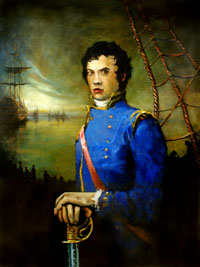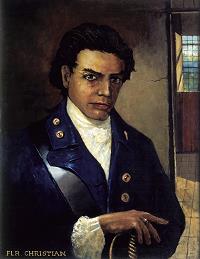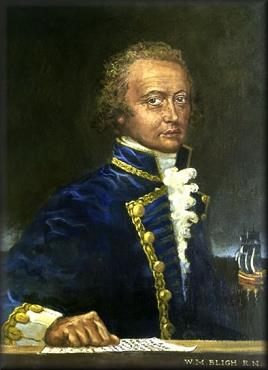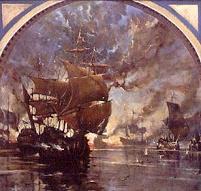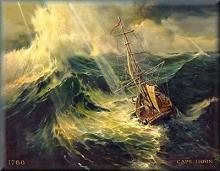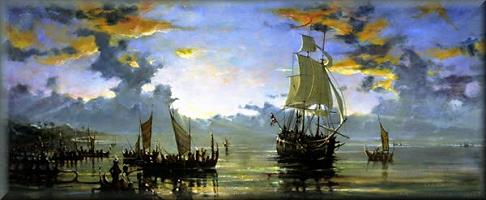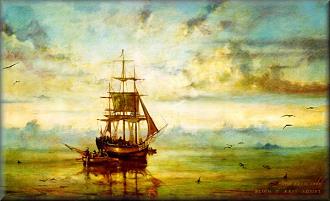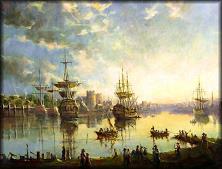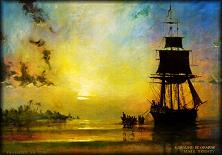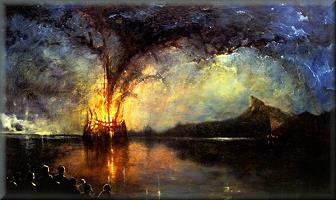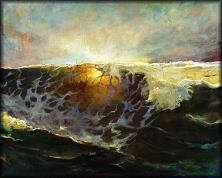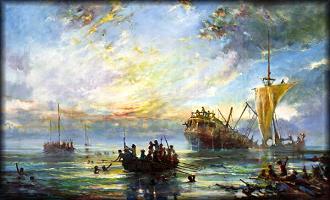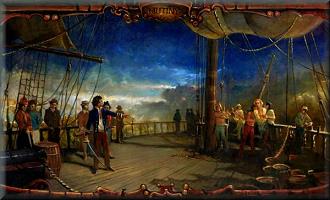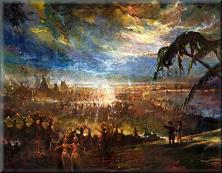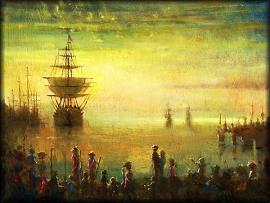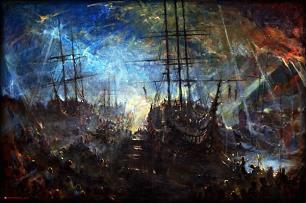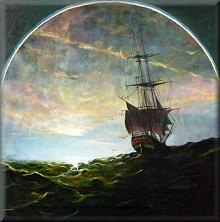|
Paintings: 'Bounty' Volumes 1 & 2
Copyright © John Hagan. 2000 – all rights reserved.
|
|
Fletcher Christian age 18(B10) This is a portrait of Christian in a dress coat and unusually holding a cutlass instead of the mandatory chart or a sextant – a clue to the violence that awaits his troubled passage through life? Being well-born Christian was more ambitious of deeds than position. This painting shows him at home on the Isle of Man after being selected as a midshipman on the Bounty. He was twenty-seven a little spoilt and enigmatic. The style of painting is seventeenth century northern renaissance with its receding background. In the 'Bounty' collection at the Pacific Union College, Angwin CA. |
|
|
Fletcher Christian age 33(B11) A wiser, less assured Christian stares out from this canvas. The symbolic curtain stands ready to be drawn on his life thus allowing the painter to create the corollary to the first portrait where a door waits to be opened. The eighteenth century loved such visual clues. In the 'Bounty' collection at the Pacific Union College, Angwin CA. |
|
|
William Bligh (B12) A portrait in the manner made popular by the French artist Fragonard – but without any cloying romanticism. It is a representation of Bligh at age thirty-four in his expensive new uniform and on his elevation to Post Captain (Captain without a command). As with most portraits of the day clues to the sitter’s rank, occupation and notoriety become elements in the finished product. Under his hand is a pamphlet advertising the 1789 publication of his Narrative. Its heading is ‘A Voyage to the South Seas.’ Bligh was the only son of a custom’s officer who died soon after Bligh was born. His mother re-married and produced a step-brother who became a pastor and one of Bligh’s greatest defenders. Bligh was a talented man of little means who greatly desired fame and fortune. His book sold well and made a tidy profit. His wife Betsy came from the Isle of Man. In the 'Bounty' collection at the Pacific Union College, Angwin CA. |
|
|
Sulphur and Saltpeter(B13) This work is a rendition of the mayhem, smoke and danger experienced in the countless naval engagements in the years between 1600 and 1790. In particular it describes a critical passage during the four day battle of 1666 between the Dutch and the English. In the foreground is the Royal Prince about to run aground on the Galloper Sand; off her stern and to port is Cornelis Tromp in Sweers’ ship the Gouda. The Royal Prince surrenders shortly afterwards (this painting is in a private collection). |
|
|
Bounty Rounds Cape Horn (B2) As we gaze though nature’s sunny smile we see her teeth fully barred ... and, as any sailor will testify ‘to be at the mercy of the sea and to survive is to be born again.’ So is the purpose of this work using warm darks to indicate the infinite depths of the southern ocean – and warm greens show the hopelessness of the situation as the waves rush up to block the light. In his ‘snowstorm at sea’ Turner painted his maelstroms by joining sky and water and all but obliterating the ship. Here and in ‘Bounty’s’ launch from Tofua to Timor’ the vessels are quite clearly depicted, hopefully without the sense of peril being diminished. (In bad weather fires were sensibly banned so hot food was rarely available to he crew – or the many injured sailors on board Bounty. The ship is rigged with minimum sail fore and aft and the wind is from the starboard quarter. After three freezing weeks Bligh finally gives the order to come about and sets a course for Capetown.) |
|
|
Bligh sails into Coupang(B14) Giving no hint of the perils of his passage the proud Bligh stands erect as the launch sails into ‘civilisation.’ This was the London idealised version and here Bligh could as well be sailing into a Dutch or English port. In reality two or three square rigged ships did stand at anchor in the busy Coupang harbour on that day but Bligh’s men were in such a perilous state they could hardly lift themselves to see over the gunwales – and thereby bear any witness to their salvation. Held in artist's collection. |
|
|
Departs Portsmouth(B15) Because of the technical difficulty of painting night scenes the task is usually attempted without great enthusiasm. This painting, in its own mediocre way, reminisces with some of J.M.W.Turner’s atmospheric works and shows Bounty under sail and disappearing into the distance. A palette of alizarin reds and cobalt and Prussian blues predominate with touches of four yellows. The rendering of the night sky is mostly by the application of transparent glazes. |
|
|
Bounty arrives Tahitie(B16) This large canvas attempts an allegory with the sunrise the beginning in the symbolic sense and a beginning of a visit in the real sense; it is also the beginning of the end as Bligh was to discover. This type of sunrise, sunset – beginning, end, transition was immensely popular in the eighteenth century where night was known as ‘a blind man’s holiday.’ The format is deliberately long and narrow to show the canoes coming from distant shores to welcome the strange visitors. Soon the natives will be swarming the decks of the Bounty. The simple style is in the manner of Cook’s travelling artist Webber but without his inclination for painting the locals as well built Grecian warriors accompanied by voluptuous Rubenesque damsels. In the 'Bounty' collection at the Pacific Union College, Angwin CA. |
|
|
Bligh is cast adrift(B17) When tragedy occurs in the middle of a calm green tropical sea the words ‘like a painted ship upon a painted ocean’ spring into the mind as if, in some contradictory way the fierceness of human behaviour could only happen in the stillness of fixed colours in setting paint, or on an artificial surface. Thus in such stillness (green being the colour of peace and clam) began a chain of events that would culminate in death – by illness in Batavia, by drowning on the Pandora, hangings at Portsmouth – and a bloody massacre on Pitcairn. Today there is a preoccupation with the subject of the painting filling the picture or touching the edges of the frame. The grand manner saw the subject reduced to a smaller element in a larger scene that otherwise hides clues to the narrative (here the discarded pot plants, circling sharks and distant storm). |
|
|
Tofua to Timor (B23) The enormity of the task, the desperate nature of their situation and the insignificance of their plight to an uncaring ocean is the preoccupation of this scene. Wet, cold and perpetual motion in an open box was the fate of those clinging to the Bounty’s launch. In construction the picture is based on a centralised dark and bottomless well. The action, like a whirlpool, gathers momentum as it drags at the edges of the picture. Overlaying this is a geometric construction of triangles and parallel lines as if to show that even in chaos nature has a design or an order. Still there is little relief for the eye ... and deliberately so as there was precious little relief for the sailors! Foam streaks the surface but there are no waves breaking. Bligh struggles with the tiller in an attempt to turn the boat into the threatening swell. |
|
|
Bounty Anchored at Point Venus Tahitie(B3) A Canaletto style composition with the low foreground and vast sky. It was a style initiated by eighteenth century Venetian painters for atmosphere rather than design (they felt little need to crowd their perfect skies). The clear unpolluted water and the clean unpolluted minds and bodies of the people as they frolic on the shore and in the sea provides the contrast to the ship’s dark menace that stains the bay with the artificiality of what Rousseau described as the 'un-natural structure and artificiality of European society.' A high value Prussian blue begins to invade some of these Otahitean scenes as they require a different palette. |
|
|
Portsmouth Harbour 1792(B4) Home of the Channel Fleet under the command of the Earl of Bridport (Lord Hood). His flagship HMS Duke with the single topmast is the large first rate on the left while HMS Brunswick the vessel designated to host the executions is anchored off her starboard bow. It is the dawn of the day of the executions... In Dickensian terms ‘It came coldly looking like a dead face out of the sky, the moon and the stars, turning pale and dying as if creation’s only purpose was its journey into death’s dominion.’
|
|
Bounty Sails South. (B18) The illustration is a portend to the approach of bad weather and it shows the insignificance of the tiny vessel in the vast southern ocean – as if, as some of the crew thought they were sailing to the precipitous edge of an ancient sea. Small waves break in exactly the same manner as tidal waves and the view of the break in the foreground is a visual clue to what lies in store. Bligh comments in his log, ‘in the afternoon, the sky is much streaked with high wind and I fear the worst.’ How right he was.(B18) In the 'Bounty' collection at the Pacific Union College, Angwin CA. A streaky, lowering sky ... |
|
|
Bligh takes his leave of Tahitie (B20) Another canvas using the low classical foreground and symbolic sky where the figures feature as players in an imagined event – this event being the impending departure of Bounty.There is an atmosphere of sadness as an earnest Bligh explains to Chief Tynah his orders and his duty. They are the dominant elements of the scene. The water looks as languid and inviting as would a warm bath to an Eskimo ... the islanders take their daily swim while a necklace of coconut palms separates the lagoon and the sky. Goethe in his ‘theory of colour’ describes yellow as the predominant colour of the middle distance – a notion borrowed here. |
|
|
Bounty Aground, Tahitie(B1) Late afternoon and Bounty is aground. She sits high on sand while the ship’s boats gather the anchors and row them to deeper water in a frantic effort to re-float her. There is no other transport home! As the sun sets so does Bounty settle – in the sand. Later Bligh suggests incompetence ... or even sabotage. The painting is as soft as the consequences are brutal. Turner once exclaimed when criticised for the use of black, ‘if I had blacker paint I would paint blacker sails – as black is the colour of death.’ |
|
|
Bounty set alight Pitcairn (B19) An attempt at the difficult fire, moon and water juxtaposition that was a popular test of skill for painters during the late eighteenth century. Pitcairn’s distinctive outline is silhouetted on the horizon. For the painting’s structure the fire takes the soot and embers aloft before their gravity force them down thus forming the arc I use to tie together the major elements of the picture. The spectators are, as usual with fire watches, undemonstrative and hypnotised by the flames. |
|
|
Behind the Wave (B2) The ghost of the Bounty lurks behind every wave. Here in the peak of a wave off the Amazon delta if we look hard enough we can just make her out. ‘So it was with Christian's fate for within nine years of the discovery of Pitcairn, three different stories were recorded relating to his death; (1) he had become insane and jumped into the sea, (2) he had been murdered by the native men, and (3) he had died a natural death. There were also three accounts of his being seen elsewhere, (1) in the English Lake District, (2) in Plymouth, and (3) in South America...’ |
|
|
Today the wreck lies scattered about Endeavour Straits (now known as Torres Straits) – as Bligh at the time predicted it would. As a sailor Edwards was not in the class of Cook or Bligh, a failing he attempted to redress by flogging his crew more often. Eventually not even this would save him and this picture shows Pandora sinking after being holed by one of the hundreds reefs dotting this narrow passage. Edwards was not one to go down with his ship but one of the first to save himself. His boat, with sail hoisted, can be seen disappearing towards the horizon. Over twenty souls perished in the wreck with some of the mutineers being dragged down by their chains. This panel shows the scene at sunrise after a night of fearful terror. The stern of Pandora with its shattered windows stares, like the face of some doomed creature, over a scene of panic and urgency that it is powerless to prevent. It is metamorphosing to become the tomb for those many still trapped inside. In ancient parlance this is a ‘closed’ picture as it tries to force the viewer into the scene by employing a tunnel like structure where the eye is forced to restlessly roam. There is little opportunity of escape. |
|
|
Mutiny on HMS.’ Bounty’ (with decoration)(B5) As the first rays of a fiery dawn transverse the deck Bligh is brought up in his nightshirt with his hands tightly bound. Most of the crew are content to stand by and watch the interaction between the protagonists. Christian shouts, ‘Hold your tongue sir, or you are dead this instant.’ These next few moments will determine the course of the rest of their lives and the realisation makes some unsure, some bold, but causes the alarmed majority to huddle in groups so far away from the action as to appear separate – but still within earshot. A vacant space in the center of the panel is there as a reminder of the gulf that had developed in the relationship between Bligh and Christian. The painting is in the neo-classical style of an operatic tableau with the main actors positioned for maximum effect. |
|
|
Celebration Feast on Tahitie(B6) After a few days the crew are invited ashore for a feast, the usual dancing and good times. |
|
|
Prisoners return (B21) As today’s arrival of the star at a movie premiere would draw crowds so in 1792 did the return of the mutineers. But then they were booed – for their crime was as much against the people as it was against the Navy. Whereas they robbed the navy of but a single ship ... they robbed the people of a dream, a dream of an attainable, contaminated paradise. |
|
Execution of mutineers (B22) In 1792 Naval executions were conducted by way of strangulation where the victims were hoisted from the deck on tackle attached to the ends of the yards. The ropes were pulled by their shipmates. In the case of the Bounty mutineers the prisoners are summoned up. As they emerge from the darkness below they look around, blinking, startled at the size of the crowd, which in turn, roars and shouts to each other then strain around corners, over heads, under awnings, to get a sight of the condemned. People in boats lay their hands on the shoulders of the people before then, fathers lift children and loved ones to a view, they stand on tiptoe, get upon gunwales, stand upon next to nothing, to see every inch of those condemned.’ |
|
‘Without atmosphere a painting is nothing.’ (Rembrant) Another symbolic representation of their transition from one world to another – ‘Mates, I draw closer to the end and I find my life travels in a circle and gets nearer to the beginning.’(early echoes of T.S.Elliot?) So spoke one of the mutineers before he was hung. Here we accompany Thomas Ellison again and see a way through the ruins of the past to an unknown future and are invited to enter – a common preoccupation now as it was in 1792. |
|
Bounty Searches for a Home (B8) Sliding away over the top of a distant sea the mutineers began the long search for anonymity and a distant paradise. The darkness of the close up waves and the strange reflecting light indicates the vessel could well spend eternity sailing in circles – a thought widely held in Europe where to abandon duty was to abandon hope. Again the blackness of the rigging is not encouraging.
|
|
|
Copyright © John Hagan. 2000 – all rights reserved. Best Viewed with 800 x 1200 resolution with Netscape Navigator 4.0+ or Microsoft Internet Explorer 4.0+ |
